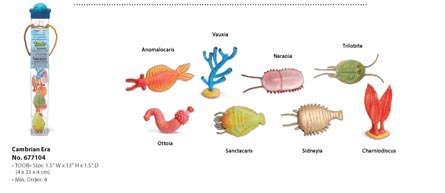Worm Wiggles its Way to Pre-eminence
Canadian Worm Wiggles its Way to Pre-eminence
In the warm waters surrounding the Cambrian continent of Laurentia lived an array of bizarre creatures, early arthropods, brachiopods and our ancient vertebrate ancestors. The Annelida (worms) were very well represented with a number of different families of segmented worms. These survivors from the Precambrian continued to diversify and flourish and if you want to find the fossilised remains of a prehistoric worm, look no further than your average Canadian construction site. That is exactly what one Canadian amateur fossil collector called “James” did, and he inadvertently helped the Royal Ottawa Museum (ROM) discover a fossil of a 480 million-year-old armoured worm.
The extremely rare fossil of an armoured worm, a fossil that predates the emergence of the dinosaurs by some 250 million years was found when a local fossil collector examined the spoil coming from the excavation of an underground car park for the World Exchange Plaza, a set of buildings that can be found in downtown Ottawa (Ontario State, Canada). However, it was not until a similar find was made in Morocco that scientists from the ROM realised the significance of the fossil found on the construction site ten years earlier.
Armoured Worm
Lead author Jakob Vinther and colleague David Rudkin have published a detailed description of this fossil in January’s edition of the scientific journal “Palaeontology”. This tiny fossil, (measuring 16 mm long), about the size of an adult man’s little finger nail represents the organism Plumulites canadensis, a member of the Machaeridian family. The significance of the Canadian fossil was not recognised until similar material was recovered from ancient marine deposits found in North Africa.
In 1998, the local fossil fan, known as “James” approached the ROM and handed the bizarre fossil to museum staff. It was not until the Moroccan material was discovered that researchers realised the importance of this ancient object. Unfortunately, the original donor of the fossil cannot be traced.
This fossil and other recently discovered material helps to cement the evolutionary link between the ancient Machaeridia and Annelid worms.
Commenting on how rare this example was, Vinther stated:
“They are really hard to find complete, fewer than ten of these fossils are known to exist. We just had these skeletons and we didn’t know what kind of animal was underneath these plates. We didn’t even know that they were worms, actually.”
Pictures show the bizarre fossil found in the spoil of a Canadian construction site. It superficially resembles the much larger Vendian organism Dickinsonia and seems to have a segmented body that has a mid-line of symmetry. This creature probably lived on or in the sea floor. It would have been a member of the epifauna. Essentially vagrant it would have roamed around the soft sea bed on thin, spindly legs that emerged in parallel out of key body segments. The strange carapace of bony plates that protected this creature was made from calcite. It would have provided some protection against marauding cephalopods or arthropods.
The emergence of hard body parts, items such as shells and an exoskeleton is evidence of the “Cambrian Explosion” a period when life in the sea diversified rapidly and the first complex predator/prey relationships were established.
Body Armour
Commenting on the body armour of this creature, Yale University graduate, Vinther added:
“A number of animals started evolving a higher level of protection in this period of time. These annelid worms, they did the same thing … that seems to correlate well with the appearance of cephalopods.”
The Machaeridia persisted for some 200 million years, finally going extinct towards the end of the Palaeozoic, but their ancestors are very much with us today and perform a number of essential roles in both marine and terrestrial eco-systems.
Strange Cambrian Fauna
The picture (above) shows the Cambrian Toob by Safari Ltd a model set that highights the bizarre nature of Cambrian fauna.
Allan Donaldson, a retired Carleton University Professor of Geology, participated in an authorised dig at the construction site of the World Exchange Plaza. He said he found the routine trilobites and shelled orthocones, but nothing spectacular like the Machaeridia this amateur found in the material removed from the spot.
“Good for him” Donaldson acknowledged.
It is hoped that all the publicity over this worm fossil will reach the ears of the local man who actually found this ancient relic of Late Cambrian marine life and he can come forward to take some of the credit for the discovery of the worm from pre-history.


